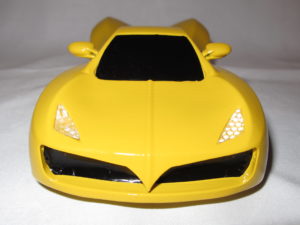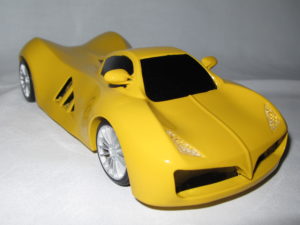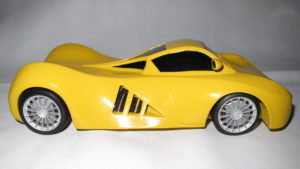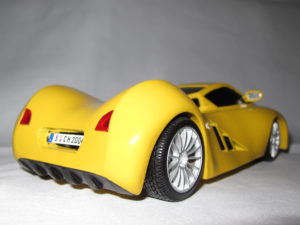 A 15 years old aspiring car designer sculpts his elaborate car design in clay but is looking for a more durable model of his cars, painted and detailed. He turns to 3D scanning for the 3D CAD data he needs to have his design fabricated.
A 15 years old aspiring car designer sculpts his elaborate car design in clay but is looking for a more durable model of his cars, painted and detailed. He turns to 3D scanning for the 3D CAD data he needs to have his design fabricated.
The Challenge:
Jamie G. from Newton, MA, is 15 years old and an aspiring car designer when he sculpted an elaborate car design in clay. Having the foresight to create a design portfolio of his work, he wanted to make a more durable model of the clay car, painted and detailed. Modeling clay was not the permanent answer.
Jamie researched various methods of 3D replication on the Internet. At first he thought about having his car machined out of aluminum, but that method soon got too expensive for his budget. He also discovered the technology called 3D scanning from Laser Design that could give him the three-dimensional CAD data he needed to have his design fabricated.
The Laser Design account manager confirmed that 3D laser scanning was the ideal solution for obtaining digital data of a malleable object such as a clay model since it is a non-contact measurement method. No destruction of the clay model or distortion in dimensions would occur because nothing touches the soft clay surface.
The account manager thoroughly discussed the project with Jamie so he understood exactly what would be done with his clay model in order to create a perfect, symmetrical CAD model. Jamie had explained in preliminary discussions that the whole model was not complete; the right side had much more detail, so the account manager suggested scanning that side, and then mirroring the data to create a completely symmetrical model.
 |
 |
 |
The Solution:
Jamie sent his 10” clay car model to Laser Design via a standard shipper. Unfortunately, while in transit the back bumper came off. This could have been a big setback to Jamie’s project because it would have been nearly impossible to re-form the clay exactly like his original hand-made creation. Laser Design engineers restored it physically as best they could for the scan, but there was still some distortion in the free-form shape. One of the big advantages of laser scanning, however, is that when the CAD model of the car is created, the damage can be corrected digitally and brought back to the design intent through the mirroring process.
Laser Design engineers scanned the clay model on the Laser Design SURVEYOR™ WS-2030 3D laser scanning system with the high-accuracy Laser Design SLP-500 laser line scanning probe (with accuracies of up to 0.011mm and 0.005mm resolution). The set-up and scanning took just 2 hours.
Because the laser scanning system projects a line of laser light onto all of the part’s surfaces while cameras continuously triangulate the changing distance and profile of the laser line as it sweeps along, the problems of missing data on a complex free-form surface are greatly reduced. The laser line moves back and forth over the part until the area is captured digitally. The system measures fine details so that the object can be exactly replicated in a CAD model. Laser scanners measure articles quickly, picking up to 75,000 coordinate points per second, and generate huge numbers of data points without the need for special templates or fixtures.
Since the car body had no internal cavity, the scan reproduced the entire part’s profile completely and precisely in the coordinate point cloud. The native software automatically connected the point cloud data from multiple views into a common coordinate system in a single scan file. After the scanning was complete, the raw data was processed and refined into a complete point cloud model. Data modeling into a symmetrical solid IGES CAD model in Pro-E took about two days. This file format was chosen because it can be used directly to create a rapid prototype. The process was somewhat iterative due to a few design changes Jamie decided to make to his model along the way. He commented, “I made some last-minute changes to my model and Laser Design was able to update the data in less than a day.” After final review, the model was ready for prototyping.
Because laser scanning is non-contact, it was able to digitize the soft clay model without compressing and distorting the shape. Using touch measurement technologies to capture the clay car model’s curved irregular shapes could have taken 20 times longer, and would have resulted in a much less complete data set. Measurements taken by hand would have been sparser, never really capturing the totality of the shape. Without non-contact laser scanning, this type of exact true-to-life shape replication would be virtually impossible.
The Results:
Jamie knew from his initial web research that once he had his detailed, symmetrical IGES CAD model, he needed to use an additive fabrication process to rapid prototype the car. Laser Design connected Jamie with a RP company who created the model in a white photopolymer resin. The rapid prototyping process went smoothly and Jamie received his professionally made model. He made sure the surface was smooth and had it expertly painted to match his original design concept in a sporty bright “Ferrari” yellow with various unique windows and other features. He said, “I am really happy with the results! Thank you so much for all of your help and advice.”
Jamie described the laser scanning process as “so cool.” “My account manager’s advice was very helpful. Working with him was by far the most painless part of researching this reverse engineering project,” Jamie explained. “I was very happy with the process.”
Jamie’s car design creativity, attention to detail, and determination in researching and following through on his modeling project will serve him well in the future. He now has a high-quality showcase part to show to automotive design industry professionals when the time comes as well as an article documenting his budding talent and actual experience in product development and fabrication. He is looking forward to producing and preserving more automotive designs soon. development is no longer needed to deliver enhanced performance replacement parts to their hot rod and vintage vehicle restoration customers.
